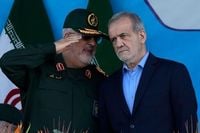Escalating tensions, piracy, and environmental threats are converging on the world’s busiest maritime oil and gas routes, raising alarms about global energy security as never before. According to Rystad Energy’s latest analysis, five key maritime chokepoints—narrow sea passages crucial for the transport of crude oil and liquefied natural gas (LNG)—are facing mounting instability. In 2023, these routes carried an estimated 71.3 million barrels per day (bpd) of oil and petroleum products and 26 billion cubic feet per day (Bcfd) of LNG. Fast forward to 2024, and those numbers have dropped to 65 million bpd and 24.8 Bcfd, reflecting the growing impact of conflict and insecurity on global trade.
While some of this decline is due to temporary disruptions—think Houthi rebel attacks near Yemen and the simmering tensions between Iran and Israel—Rystad points to a deeper, structural shift. Vessels and cargoes are increasingly rerouting via the Cape of Good Hope and alternative pipelines, fundamentally altering the flow of global energy. "We have identified the five chokepoints most at risk, assessed the threats they face and outlined the far-reaching consequences for global energy markets," said Mrinal Bhardwaj, Senior Analyst, Upstream Research at Rystad Energy, in comments reported by BusinessDay. "Any disruption at these chokepoints could shatter supply chains, trigger sharp spikes in energy prices and inflict severe economic damage worldwide."
Insurance premiums and freight rates have already surged in response to the instability, Bhardwaj warned, adding that a full closure of any chokepoint could send energy prices soaring and test the resilience of global supply chains. The stakes are enormous: about three-fourths of the world’s oil trade passes through maritime chokepoints, with a quarter via the Strait of Malacca and a fifth through the Strait of Hormuz.
Strait of Malacca: Asia’s Energy Lifeline
The Strait of Malacca stands as the world’s largest trade chokepoint, handling approximately 24 million bpd of oil and gas as of 2024. This narrow corridor between the Indian and Pacific Oceans is a critical artery for transporting Middle Eastern crude and LNG to Asia, especially to China and Japan. China alone accounts for 50 percent of the route’s imports, while Saudi Arabia is the leading exporter, responsible for 25 percent of the share. Since the pandemic, oil and gas flow through the strait has increased by 2.1 million bpd. Despite its reputation for piracy and theft, no major incidents have been reported this year, according to Rystad Energy.
Strait of Hormuz: The World’s Most Critical Chokepoint
Perhaps nowhere is the geopolitical tension more palpable than in the Strait of Hormuz, which sits between Iran to the north and Oman and the United Arab Emirates to the south. Roughly one-fifth of the world’s maritime oil and condensate trade—nearly half of the Middle East’s daily oil output, or about 14 million bpd—flows through this narrow waterway to major Asian markets like China and India. About half of Saudi Arabia and the UAE’s daily oil exports, and a quarter of China’s daily oil demand, are shipped through the strait. It’s also a key LNG route: about one-fifth of globally traded LNG volumes pass through here, with Qatar exporting two-thirds of its daily gas production (about 16.3 Bcfd) to countries such as China, India, and South Korea. In fact, China’s LNG imports via the Strait of Hormuz have increased about 2.5 times in the last five years, reaching 2.7 Bcfd.
The strategic importance of the Strait of Hormuz was dramatically underscored during the recent Iran-Israel conflict. Iran’s parliament even proposed a bill to close the strait, though the plan was deferred. "If the strait were to be closed, it could disrupt nearly half of Middle Eastern oil exports, severely impacting global oil and gas transportation," Bhardwaj told BusinessDay. "This would likely lead to a sharp increase in global oil prices and raise energy import costs for dependent nations, affecting the entire oil and gas supply chain."
To mitigate such risks, countries in the region have developed alternative oil transport routes. Saudi Arabia’s East West Crude Pipeline offers a capacity of 5 million bpd, the UAE’s Abu Dhabi Crude Oil Pipeline can handle 1.8 million bpd, and Iran’s Goreh Jask pipeline provides another export route that bypasses the Strait of Hormuz entirely.
The Red Sea and the Suez Canal: Bab el-Mandeb’s Fragility
The Bab el-Mandeb Strait, connecting the Red Sea with the Gulf of Aden and the Arabian Sea, is the Middle East’s second major chokepoint. It serves as a vital link for ships transiting between the Suez Canal and the Indian Ocean. Before a wave of Houthi attacks on commercial vessels and tankers in late 2023, the Bab el-Mandeb accounted for about 12 percent of global seaborne oil trade. However, the surge in attacks in December 2023 caused daily shipping volumes through the strait to drop by nearly 50 percent within six months, with traffic still below normal levels as of October 2025. A full closure would force vessels to bypass the Suez Canal altogether, redirecting them around the Cape of Good Hope, which adds time and cost to already strained supply chains.
Turkish Straits: Europe’s Strategic Crossroads
The Turkish Straits—comprising the Bosporus and Dardanelles—are another strategic bottleneck, connecting the Mediterranean Sea and the Black Sea. They handle around 3.5 million bpd of crude oil and 0.5 Bcfd of LNG, about 5 percent of global maritime oil trade. Transit volumes dropped during the Russia-Ukraine conflict but rebounded to 3.4 million bpd in 2023. The narrow waterways, however, remain vulnerable to congestion, accidents, and political interference. Pipelines such as the Baku–Tbilisi–Ceyhan and Iraq–Turkiye provide alternative routes.
Cape of Good Hope: The New Bypass
At Africa’s southern tip, the Cape of Good Hope has re-emerged as a critical bypass amid Red Sea instability. Once handling about 6 million bpd, traffic surged 50 percent to 8.7 million bpd in 2024 as shippers avoided the Suez Canal. About 40 percent of oil via the Cape now goes to China, with a third from the US and a quarter from South America. Middle Eastern producers like Saudi Arabia and Iraq have also diverted exports to Europe through this route. Despite longer journeys and higher costs, the Cape is seen as one of the world’s safest maritime routes, underscoring its growing importance for energy security.
Iran’s Strategic Messaging and Military Posturing
While the physical risks to shipping are clear, the political and military dimensions are equally significant. On October 6, 2025, Major General Seyed Abdolrahim Mousavi and Major General Mohammad Pakpour of Iran’s armed forces visited naval units on the Persian Gulf islands. During the visit, a live feed showed an Iranian drone flying over a U.S. aircraft carrier, with the carrier apparently unaware of the UAV’s presence. As reported by WANA News Agency, this demonstration signaled Iran’s ability to track U.S. naval movements in real time, and highlighted the strategic importance of the Strait of Hormuz as leverage in any potential conflict scenario.
The visits served dual purposes: psychological deterrence—projecting an image of capability to influence regional and extra-regional rivals—and operational preparation for real-world scenarios. Iran is enhancing both offensive and defensive naval capabilities amid heightened tensions following the reinstatement of UN sanctions via the snapback mechanism by three European powers. The snapback sanctions, activated just before October 6, 2025, target Tehran and have broader regional and commercial implications, especially for shipping lanes through the Strait of Hormuz.
Iran’s naval displays are widely seen as a strategic response to these sanctions, signaling its ability to complicate or raise the cost of commercial shipping, and applying psychological pressure on European capitals. Tehran is effectively presenting adversaries with two options: accept these naval maneuvers as diplomatic leverage and yield concessions, or risk escalation in the Persian Gulf region. As BusinessDay and WANA both suggest, the crucial question now is whether these signals will be seen as controlled threats—or as sparks that could ignite a much wider confrontation.
With energy flows rerouted, insurance premiums climbing, and military posturing intensifying, the world’s maritime chokepoints have become ground zero in the struggle for global energy security. The next chapter in this high-stakes drama, it seems, is still being written.

